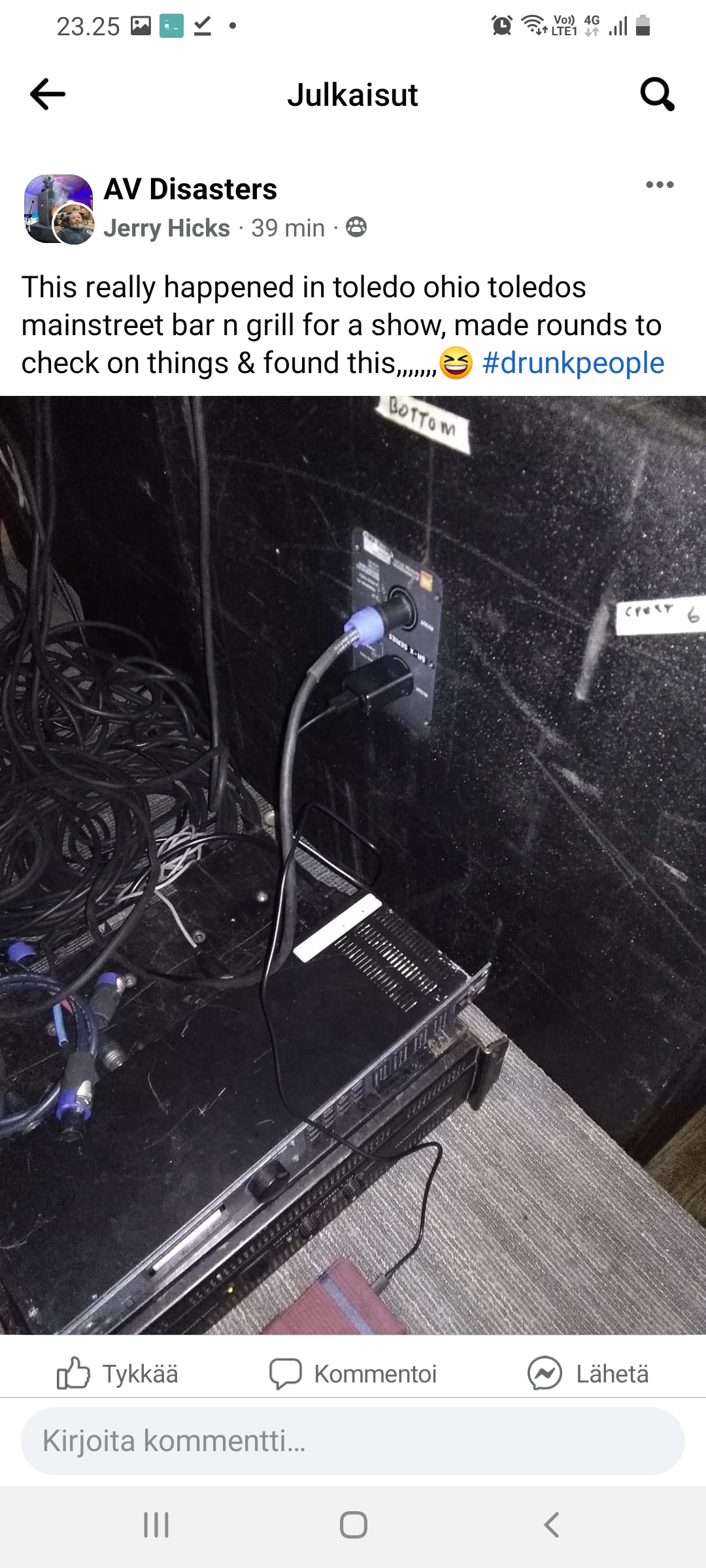I just saw this Facebook post in AC Disaster group and had to react to it!

Source: Post by Jerry Hicks at AV Disasters Facebook group (used with permission)
Almost clever!
You can actually plug in US charger to speakon connector and have it to make contact with two “pins” (1- and 2-).
You can power a 110V mains device with the output of a powerful audio amplifier that outputs high amplitude 50 or 60 Hz (or something close enough for device to accept it, many small chargers can accept quite wide frequency range). Dave Rat has video where he powers one PA amplifier from the speaker output of another one.
This can be made to work if you want to put effort to it, but generally does not work well.
Video: Wall Voltage From and Audio Amp & Does Hot AC give more Watts? (Public)
2 Comments
Tomi Engdahl says:
Why was NL4FX discontinued? : r/livesound https://share.google/upVqK2tGRKo63X5IU
Why was NL4FX discontinued?
Question
I’m not sure If this is in the right subreddit so if it’s not please either delete it or let me know and I’ll delete it!
I recently heard about the new Nl4 connector NL4FX and kind of thought it was pointless and a cash grab, but I just heard that they discontinued them. Does anyone know the official reason?
European norms on child safety with bare electrical wires. They could open the plugs and expose the wires just by twisting, but now it needs a specific tool.
About the tool – could be a cash and grab, but you can easily make one with a cnc cutter out of wood for example. Dave Rat did just that
Not sure why the tool was initially so expensive (other than the fact that their tools are always way overpriced), but from talking to them at tradeshows they’ve said they tried to make the tool as simple to replicate as possible and have left the exact designs online so you can easily cut or print your own.
Thank god! I always have wild children running around my speaker cable trying to untwist the connectors. Phew!
I’m not aware of any sort of press release or patch notes (ha) Neutrik have ever released. I think the overall construction is improved—it’s fewer parts and clearer assembly now—and Torx is a better screw for that purpose anyway. Very silly about the proprietary tools.
Tbh you don’t “need” the proprietary tool, you just need something that fits on the flat end, like a adjustable wrench one one with a compatible size
I had wondered about just using an adjustable wrench. I haven’t seen the new connectors up close but what I’ve seen online it looks like a wrench would work.
Old powerCons used to require a 7/8” wrench on the boot IIRC
This is just dumb. Didn’t the older style (don’t know the model) need a small screwdriver to remove the locking sleeve?
I always liked those connectors better anyway. The nl4fx or 2pole eq seemed more bulky and annoying and depending on the equipment or rack mound did not easily have the clearance.
It’s a money grab if you ask me.
The ones you need the screwdriver to open were an absolute pain
I don’t know, but I just finished a nightclub install with the new ones and I am not a fan. Had to do a bunch of 4 x 4mm cables and it took me twice as long and my fingers were killing me.
Because there were too many FX connectors (not to speak of the dreadful clones) floating around in good enough condition and being reused (slow sales) so the heads got together and decided they are ‘not safe enough’ and/or could sell some more stuff.
Persuade someone it is now “best practice” so that hire houses and large venues could be expected to upgrade. I’m sceptical on the ability or likelihood of a child to open one and cause self harm from one connected. I would be interested to hear of any genuine accidents caused by a child opening an NL4X connector. Tooling requirements is rarely a way to prevent unauthorised openings.
I haven’t had the new ones to test, I am interested as torx is better in my opinion as long as the screw head doesn’t corrode or metal end up too soft. Wondering if it’s any better to verify connections in poor light.
Tomi Engdahl says:
https://youtu.be/RDs8a_ym3Zc?si=y6XKmgAIwLgBtwEH